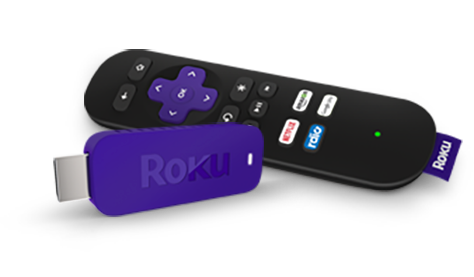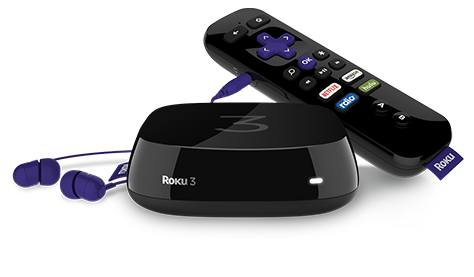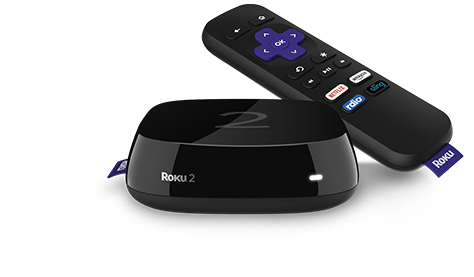I feel like a blog post on this is appropriate because I have had several people ask me how we make life without cable work.
Like everybody else, after a year with Direct TV our bill shot up, and after a few phone calls trying to negotiate, it didn't look promising that the bill was going to get any better. It's not really that we couldn't afford the cable, I just found it so ridiculous to spend that much money each month when we watched so few channels. I knew there had to be a way around it when all we really wanted were just a few basic channels and ESPN. So, I started doing some research on "cord-cutting", as it's called in internet world, to see if we could come up with something that would work for us.
We have gone without cable before and just used an HDTV antenna hooked up to each TV. We were living in a bigger city at the time, so we could place the antenna anywhere we needed to and got clear reception of every major channel. Now, because of where we live relative to the stations, we cannot get all the major channels just by plugging up an antenna and sitting it beside our TV. The main one not coming through for us was ABC.
Being the avid college football fans that we are, it wasn't realistic for us to just sign up for Netflix and call it a day. We knew we needed some way to get our ESPN channels and also a reliable ABC channel since a lot of big games also come on ABC, so that was my biggest priority when researching options.
Here is what we use:
This is simply the device that allows you to get all of your "internet TV" (i.e. Netflix, Hulu, Sling, etc) onto your TV. Roku is the one we ended up choosing but there are lots of devices that serve the same purpose.. Apple TV, Amazon Fire Stick, Chromecast, etc. We have three different Rokus plugged into each of our three TVs.
You may be thinking "Which Roku?". There is the Roku 3, Roku 2, and Roku Stick all at different price points.
 | ||
Roku Stick- $40
|
 |
| Roku 3- $80 |
After doing some reading I basically concluded that, unless you do serious gaming, the major difference between the Roku Stick vs the Roku 2 or 3 is speed. The Roku boxes (the 2 and 3) run a little bit faster in terms of turning on, opening an app, etc compared to the Roku stick. The Roku stick plugs into the back of your TV so it is a great option if you have a wall-mounted TV in order to minimize clutter. It's also easily transportable if you want to move it back and forth between TVs. The Roku 2 vs the Roku 3 run at the same speed. The Roku 3 just has a few extra bells and whistles compared to the Roku 2. We ended up going with two Roku sticks and one Roku 2 and haven't had any issues with any of them.
Looks like there is also now a new Roku 4.. I don't know anything about it. This site compares all the Roku models out there.
This is how we watch local network channels (NBC, ABC, Fox, CBS, etc). We connect our HDTV antenna to the Tablo and our Tablo is in turn connected to our Internet router. This allows the Tablo to send out the HDTV antenna signal wirelessly to all the TVs in our house. We can then watch the channels by pulling up the Tablo app on the Roku. One added perk is that it also serves as a DVR so we can actually record, pause, fast forward, and rewind network channels.. for free! :)
The reason the Tablo is so important is because it allows us to use ONE antenna that we can put in the room in our house where we get the best signal. Then, the Tablo takes this one signal and sends it to all of our TVs via the Roku app. We still werent sure if we would be able to get ABC this way but it was our only shot. So we bought an HDTV antenna that advertised a farther signal range and tried it out. The first thing we did was plug the new antenna directly into the TV so we could see the picture coming through and spent some time with the placement of the antenna to figure out where we got the best signal. You really have to spend some time on this part because the difference of moving it just a few inches can change your signal. Turns out with the higher powered antenna and strategic placement we were able to get a pretty reliable ABC channel. The strength of antenna that you need and where in your house to place it will be different for everybody depending on where you live relative to your station signals. You do need to make sure that you have a phone jack nearby though because the Tablo has to be plugged into your internet router which usually has to be plugged into your phone jack.
This link is a great source of information that might explain all of that a little better than I did.
Here's a look at what it looks like on your TV:
This screen shows what's on now and what's upcoming. Just like what you're used to with Cable TV. The orange square indicates a show that you have scheduled to record.
This screen shows what you already have recorded, ready to watch anytime.
Here's what you need to set up a Tablo:
- TV with Roku or some other streaming device (Apple TV, Amazon Fire, etc)
- Tablo - $200 for the 2-tuner
- There is a 2-tuner or 4-tuner option. This has to do with how many channels you can record at a time: 2-tuner records up to two channels simultaneously, the 4-tuner can do 4 channels at a time. We have the 2-tuner and have never had a need to record 4 channels at one time
- HDTV antenna
- This is the one we have; $60
- External Hard Drive
- This is the one we have; $57
- The capacity will determine how many recorded shows you can store. We got 1TB and have more than enough. Right now we have over 100 shows recorded and aren't even half way full.
Now remember, the Tablo only allows you to watch and record local network channels. This still does not give you ESPN or any other cable channels.
Sling streams live TV over the internet and is the "new alternative to cable" that allows you to watch a handful of cable channels without the contracts and high prices of cable companies. It starts at $20 a month with no start up fees and no contracts. You can start and cancel at any time with no penalty. After signing up online you can watch the channels through your Roku via the Sling app.
This is our solution to ESPN and other sports channels. The basic package is $20 per month and includes ESPN, ESPN2, AMC, TNT, TBS, CNN, A&E, Lifetime, History, Food Network, HGTV, Travel Channel, Cartoon Network, Disney Channel, ABC Family, History, and a few others. After that you can add on other packages to gain additional channels. We added on the "Sports" package for an extra $5 (for a total of $25/month) which included ESPNU, ESPNews, SEC Network, Universal Sports, and others. You can also add HBO, Showtime, and many others all for extra fees.
The main way we used our Sling subscription was through the WatchESPN app. You can pull up WatchESPN app on the Roku and sign in using your Sling account. Once you're signed in you can pull up all the games available on WatchESPN. This was the easiest way for us to see all the games in one place and switch back and forth between games a little quicker.
You can NOT record, pause, rewind, or fast forward any shows through Sling and it does NOT give you access to local channels. You can only watch the shows live, at the time they come on (SO 2000s, I know).
Sling does usually have a deal where you can get a free Roku Stick or $50 off a Roku 3 ($50 value either way) when you prepay three months. So we did take advantage of that for one of our Roku Sticks.
Etc...
In addition to all of this you can also use Netflix, Hulu, Amazon Prime, etc which can give you access to some other popular shows you may not have access to through the ways I've previously mentioned. Right now we don't have subscriptions to any of these. Between the local channels, all the shows we have built up on the Tablo DVR, and football, we really have plenty to watch. We may decide to add a Hulu or Netflix subscription once football season is over.
Here's a list of some of the sacrifices/cons I have dealt with with our new set-up:
- The live sports run about a play behind.
- Not really an issue unless you are following twitter or texting someone that is watching it on regular cable.. then you might run into some spoilers.
- No E Network.
- This really won't affect most people, but it was a major sacrifice for me at first. Unfortunately, E Network is not an option with the Sling subscription, and, for some reason, they don't post any of their shows on Hulu. It's probably not a bad thing that I have a little less Kardashian in my life, but I do miss catching up each night with E news, and I'm REALLY going to miss the red carpet shows during awards season in a few months.
- Harder to "channel surf".
- Because you are basically watching everything via an Internet connection, it takes a lot longer to change channels, so you really can't jump from channel to channel like you can with cable. This mainly is an issue for football when you are trying to switch from game to game. We learned to just pick one game and follow the scores of the others on our phones. Then during half time or a long break we would switch to another one. Really a small sacrifice when you consider the money you are saving.
- Requires a good internet connection.
- Literally everything you are watching requires an internet connection, so you need a good one! We increased our internet subscription to the next level up for a little extra boost.
- Poor signal in bad weather.
- Let's be honest.. this was an issue with DirectTV as well. This only applies to our antenna channels, and really the only channel that we have an issue with in bad weather is ABC, which is our weakest signal to begin with. All other channels have no issue.
- Can't record sports
- We usually like to record Clemson games so that we can re-watch them later. Unless they are playing on ABC, we can't do this with our new set up. However, WatchESPN usually has replays at least for a week or so afterwards, and most old games can be found on YouTube which you can play on your TV through the Roku app. So we can pretty much get around this issue.
Startup Cost (for us):
- Roku:
- Roku Stick- free with 3-month Sling subscription
- Roku Stick- $50
- Roku 2 Box- $70
- Tablo 2-Tuner: $198
- HDTV Antenna: $63
- External Hard Drive: $59
Potential monthly costs:
- Sling: $25/month for basic package plus sports extra
- can sign up and cancel at any time
- Tablo: $4.99/month
- This fee gives you the programming guide that shows you what's on and upcoming. This is not technically required but makes using it SO much easier and definitely worth $5/month.
- Netflix: $8/month
- Hulu plus: $8/month
- Good Internet Connection: right now we have U-verse that runs ~$50 per month
This method has worked for us since we canceled our cable in August. The start-up cost was expensive, most of that being the Tablo, but it has definitely saved us ALOT of money each month, and the negative aspects have definitely been worth dealing with when we consider how much we save. Our DirectTV bill was over $100 per month, not including internet so it doesn't take long for the Tablo and Rokus to pay themselves off.
I hope this helps somebody out there! Let me know if you have any questions on how you can make this work for you! I'm no expert, but I can try to help the best I can!





No comments:
Post a Comment